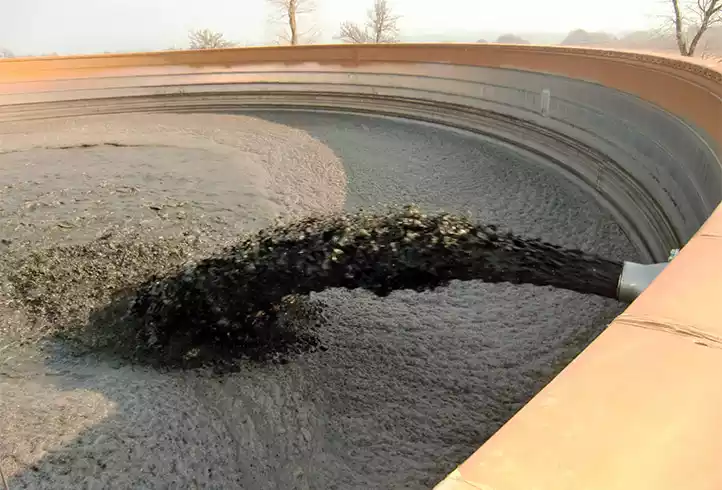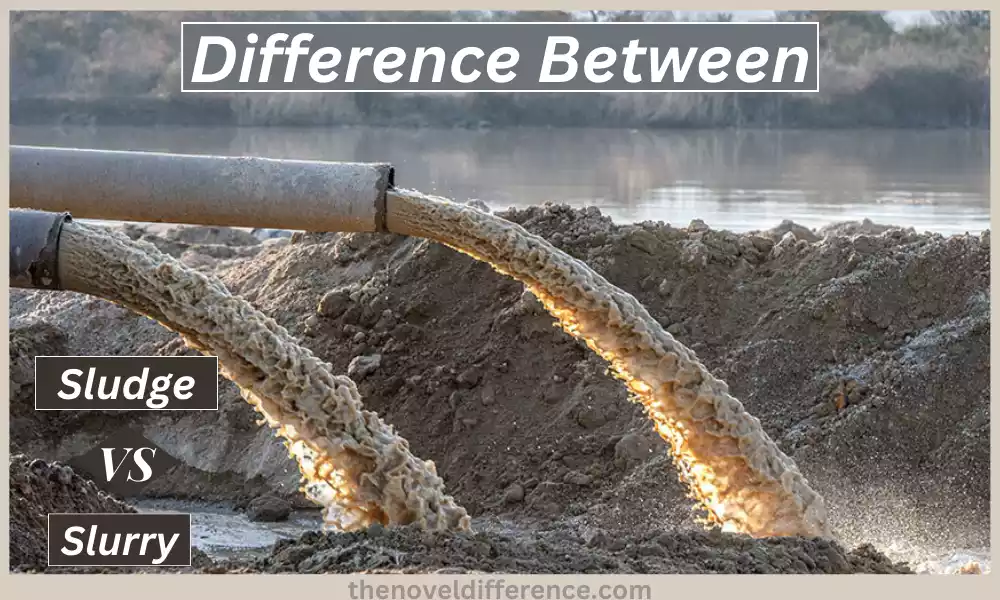Definition of Sludge and Slurry
Sludge refers to a semi-solid residue or sediment that is typically generated as a byproduct of various industrial, municipal, or biological processes. It consists of a mixture of water, solid particles, and sometimes organic matter. Sludge often has a high solid content and exhibits a thick, viscous consistency.
Slurry refers to a fluid mixture consisting of a liquid phase and solid particles suspended within it. It is typically a flowing or pumpable substance with varying viscosities, depending on the concentration and size of the solid particles.
The slurry is often utilized by industries including mining, construction, and transportation as an effective medium for solids transportation or specific applications requiring a mixture of liquid and solid components.
Characteristics of Sludge
Characteristics of Sludge:
- Composition: Sludge is usually composed of water mixed with solid particles and sometimes organic material. The composition can vary depending on the source and the process that generates it. It may contain suspended solids, colloidal particles, microorganisms, chemicals, heavy metals, and other contaminants.
- Water Content: Sludge generally has a high water content, ranging from 70% to 99%. The exact water content can vary depending on the type of sludge and the treatment processes it has undergone. High water content contributes to its thick and semi-liquid consistency.
- Solid Content: Sludge contains a significant amount of solid particles. The solid content can range from a few percent to as high as 40% or more, depending on the type of sludge. The solid particles can be organic or inorganic and may include sediment, debris, microorganisms, or precipitates.
- Texture and Consistency: Sludge exhibits a thick, viscous consistency and may have a sticky or gel-like texture. It is often non-homogeneous, with variations in density and flowability. The texture and consistency of sludge can be influenced by factors such as the concentration of solid particles, the presence of organic matter, and the treatment processes applied.
- Formation and Sources: Sludge is formed as a byproduct of various processes, including wastewater treatment, industrial manufacturing, agricultural activities, and biological decomposition. It can be generated from sewage treatment plants, industrial effluent treatment, mining operations, oil refineries, and other activities that produce liquid waste containing solid particles.
- Odor: Sludge can have an unpleasant odor due to the presence of organic matter and microbial activity. The odor can vary depending on the composition and stage of decomposition of the sludge. Certain types of sludge, such as anaerobically digested sludge, may have a powerful and offensive odor.
- Settling Behavior: Sludge tends to settle over time due to its highly solid content. When left undisturbed, the solid particles in sludge will gradually settle tothe bottom, resulting in a more compacted layer of sediment. The settling behavior of sludge is important to consider during treatment processes and handling to ensure efficient separation and dewatering.

It’s worth noting that the specific characteristics of sludge can vary depending on factors such as the treatment processes applied, the nature of the waste or wastewater, and the industry or source from which it originates.
Characteristics of Slurry
Characteristics of Slurry:
- Composition: A slurry is a mixture of a liquid phase and solid particles suspended within it. The liquid phase is usually water, but it can also be another liquid such as oil or a chemical solution. The solid particles can vary in size and composition, ranging from fine particles to larger aggregates.
- Viscosity and Flowability: Slurry exhibits varying viscosities, depending on the concentration and size of the solid particles and the properties of the liquid phase. It can range from relatively low viscosity, resembling a fluid, to higher viscosities with a thicker consistency. The flowability of the slurry allows it to be pumped, transported, or poured.
- Particle Suspension: The solid particles in a slurry are suspended or dispersed throughout the liquid phase, forming a homogenous or heterogeneous mixture. The particles may remain suspended for a considerable time due to the liquid’s viscosity and the presence of additives or chemicals that enhance particle suspension.
- Concentration: The concentration of solid particles in a slurry can vary widely depending on the application and industry. It can range from dilute mixtures with low solid content to concentrated slurries with a high proportion of solid particles. The concentration affects the overall viscosity and behavior of the slurry.
- Abrasiveness: Slurry can be abrasive due to the presence of solid particles. Depending on the size and hardness of the particles, the slurry can cause wear and damage to equipment and piping systems that come into contact with it. This abrasiveness is an important consideration for material selection and equipment design.
- Settling Behavior: Unlike sludge, which has a high tendency to settle, the slurry is designed to resist settling. However, over time, depending on the properties of the slurry, some settling or separation of solid particles from the liquid phase may occur. This settling behavior can be controlled through the addition of stabilizers or continuous agitation.
- Application-Specific Properties: The characteristics of slurry can be tailored for specific applications. For example, in mineral processing, slurries are often designed with specific rheological properties to facilitate particle separation or flotation. In construction, slurries may be formulated with specific additives to enhance workability or strength in concrete production.

It’s important to note that the specific characteristics of a slurry can vary significantly depending on factors such as the nature and size of solid particles, the properties of the liquid phase, and the intended application. Different industries and processes may require specific properties and adjustments to optimize the performance of the slurry.
Sludge vs Slurry in Tabular Form
Certainly! Here’s a comparison of sludge and slurry in tabular form:
| Features | Sludge | Slurry |
|---|---|---|
| Composition | A mixture of water, solid particles, and sometimes organic matter | A mixture of liquid phase (e.g., water) and suspended solid particles |
| Consistency | Thick, semi-solid | Fluid |
| Solid Content | High | Lower |
| Viscosity | High | Varies and can range from low to high |
| Settling Behavior | Tends to settle over time | Designed to resist settling |
| Applications | Wastewater treatment, agriculture, industrial processes | Mining, construction, drilling mud, fluid transport |
| Handling | Requires specific handling and disposal methods | Easier to handle, transport, and pump |
| Environmental Impact | Can contain contaminants, and the potential for pollution if not managed properly | Risks of spills can impact water quality if not properly contained |
| Example Uses | Soil conditioner, fertilizer, an industrial byproduct | Mineral transport, concrete production, drilling mud |
This table highlights the key differences between sludge and slurry, including their composition, consistency, solid content, viscosity, settling behavior, applications, handling requirements, environmental impact, and example uses. It provides a concise comparison of the two mixtures, allowing for a quick understanding of their distinguishing characteristics.
Importance of – Sludge and Slurry
Understanding the difference between sludge and slurry is crucial, particularly in industries like waste management, environmental engineering, and manufacturing. These materials, while similar in appearance, have distinct properties and chemical compositions, necessitating different handling, treatment, and disposal methods.
Proper identification ensures the application of the most effective and environmentally responsible treatment techniques. This knowledge is vital not only for operational efficiency and compliance with regulatory standards but also for minimizing potential environmental impacts.
By accurately distinguishing between sludge and slurry, industries can optimize resource use, reduce waste, and contribute to sustainable practices.
Physical Properties
Physical Properties of Sludge:
- High Solid Content: Sludge typically has a high concentration of solid particles, which contributes to its thick and semi-solid consistency. The solid content can vary depending on the type of sludge and the treatment processes it has undergone.
- Non-Newtonian Behavior: Sludge often exhibits non-Newtonian flow behavior, meaning its viscosity and flow characteristics are not constant under different shear rates or stresses. It may display shear-thinning behavior, where the viscosity decreases as the shear rate increases, or shear-thickening behavior, where the viscosity increases with the shear rate.
- Settling: Sludge tends to settle over time due to its high solid content. When left undisturbed, the solid particles in sludge will gradually settle to the bottom, resulting in a more compacted layer of sediment. The settling behavior is influenced by factors such as particle size, density, and the presence of flocculants.
Physical Properties of Slurry:
- Fluid Nature: Slurry is primarily a fluid mixture due to the liquid phase it contains. The liquid component, usually water, imparts fluidity and allows the slurry to flow, be pumped, or transported.
- Viscosity Variability: The viscosity of slurry can vary depending on factors such as the concentration and size of the solid particles, the properties of the liquid phase, and any additives or chemicals present. It can range from low viscosity, resembling water, to higher viscosity, with a thicker consistency.
- Particle Suspension: Slurry maintains solid particles suspended within the liquid phase, creating a homogeneous or heterogeneous mixture. The suspension allows for easy transportation and pumping of the slurry.
- Particle Settling Control: Slurry is designed to resist the settling or separation of solid particles from the liquid phase. Various methods, such as continuous agitation or the addition of stabilizers, can control settling behavior and maintain particle suspension over extended periods.
- Rheological Variations: Slurries can exhibit different rheological properties depending on the specific application or industry. These properties include shear-thinning or shear-thickening behavior, yield stress, and viscoelasticity. Tailoring the rheological characteristics of a slurry is important for optimizing its performance in processes such as transportation, mixing, or separation.
It’s important to note that the physical properties of both sludge and slurry can vary based on the specific composition, treatment processes, and industry/application involved. These properties play a significant role in determining how sludge and slurry behave, how they can be handled, and their suitability for various processes or applications.
Applications and Uses
Applications and Uses of Sludge:
- Wastewater Treatment: Sludge is a byproduct of wastewater treatment processes such as primary sedimentation, biological treatment, or sludge dewatering. It can be further treated through anaerobic digestion, aerobic digestion, or other methods to reduce its volume and stabilize its organic content. The treated sludge, known as biosolids, can be used as a soil conditioner or fertilizer in agriculture.
- Industrial Processes: Sludge generated from various industrial processes, such as manufacturing, chemical production, or metal finishing, may undergo treatment for proper disposal or recovery of valuable components. Some industrial sludges can be used as raw materials for the production of building materials, fuel, or other industrial products.
- Agriculture and Soil Amendment: Treated sludge or biosolids can be applied to agricultural land as a soil amendment. They enrich the soil with organic matter, nutrients, and beneficial microorganisms, improving soil structure, fertility, and water retention. Sludge application helps promote crop growth and reduces the need for synthetic fertilizers.
Applications and Uses of Slurry:
- Mining and Resource Extraction: Slurry plays a crucial role in the mining industry for the transportation of ores, minerals, and waste materials. It is used in processes such as mineral beneficiation, coal washing, or tailings disposal. Slurry pipelines or slurry pumping systems are utilized to efficiently transport solid materials over long distances.
- Construction and Concrete Production: Slurry is used in construction for various purposes. It is often used in concrete production as a component of the mix, enhancing its workability, fluidity, and strength. The slurry can also be employed for grouting, soil stabilization, or tunneling processes.
- Transportation of Liquids: Slurry can be used to transport liquids containing solid particles. For example, in oil and gas industries, drilling mud is a type of slurry used to cool and lubricate the drill bit, remove cuttings, and maintain pressure during drilling operations. Slurry pipelines are also employed for transporting abrasive or corrosive liquids in industries such as chemical processing or mineral extraction.
- Ceramic and Glass Manufacturing: Slurry is utilized in the production of ceramics, glass, and other fine materials. It is used for shaping and forming processes, such as slip casting or glass fiber production. Slurry provides the necessary fluidity and suspension of solid particles during these manufacturing processes.
- Environmental Remediation: Slurry can be used in environmental remediation projects for activities such as soil washing, contaminated sediment remediation, or groundwater treatment. Slurries containing chemicals or sorbents are applied to extract or bind contaminants, facilitating their removal from the environment.
It’s important to note that the applications and uses of both sludge and slurry can vary depending on the specific industry, processes involved, and local regulations. The suitability and proper handling of sludge and slurry are critical factors in ensuring their safe and effective utilization in various applications.
Treatment and Management
Treatment and management of sludge and slurry involve different techniques due to their unique properties. Sludge, often heavier and thicker, is typically treated through processes like dewatering to reduce moisture, and stabilization to minimize odor and pathogen content. This makes it safer for disposal or use in applications like agriculture.
On the other hand, slurry, with its higher fluidity, is commonly managed through methods like sedimentation and filtration to separate solids from liquids.
These processes are crucial in reducing environmental impacts and making the materials suitable for disposal or recycling in various industrial applications. Efficient management of both sludge and slurry is key to minimizing ecological footprint and adhering to environmental regulations.
Real-world Examples
In the real world, the difference between sludge and slurry can be seen in many industries. For example, in wastewater treatment plants Sludge is a byproduct processed through processes such as anaerobic digestion, which produces biogas, which is a renewable energy source.
However, in the mining sector, it is common for slurry (a mixture of finely ground rock) to be controlled by settling ponds in which the solids can settle before the water can be recycled or processed for discharge.
Another instance is in the construction industry in which concrete slurry gets created during grinding and cutting processes and requires special disposal procedures to prevent pollution of the environment. These examples illustrate how different industries manage sludge and slurry by the environment’s standards and sustainability goals.
Conclusion
Sludge and slurry are distinct mixtures with different characteristics and applications. Sludge is primarily composed of water, solid particles, and potentially organic matter, with a high solid content and thick, semi-solid consistency.
It is often generated as a byproduct of wastewater treatment or industrial processes and requires specific handling and disposal methods. Sludge finds applications in wastewater treatment, agriculture, and various industrial processes.
On the other hand, slurry is a mixture of a liquid phase (such as water) and suspended solid particles. It has a lower solid content and a more fluid nature, allowing for easier transportation and pumping.




